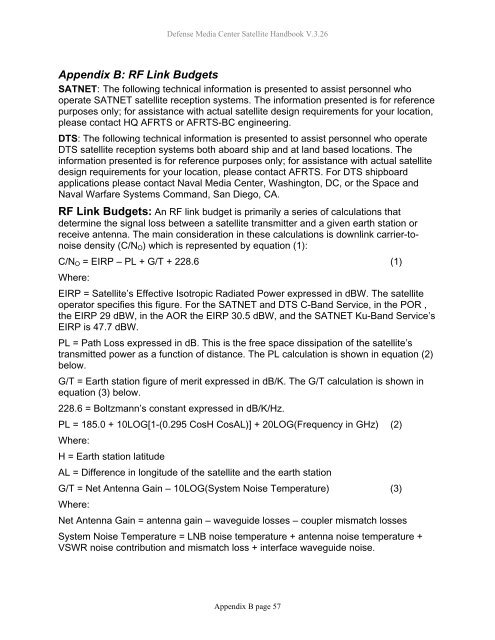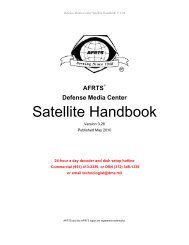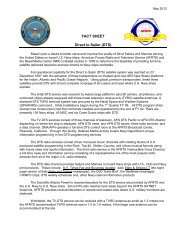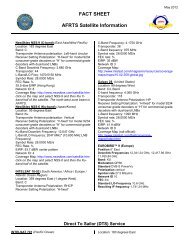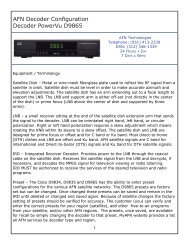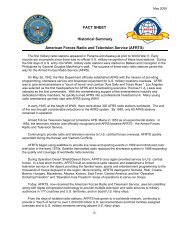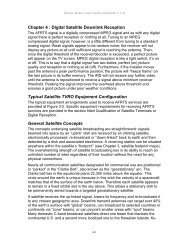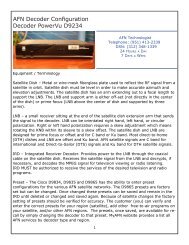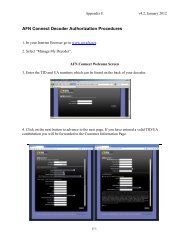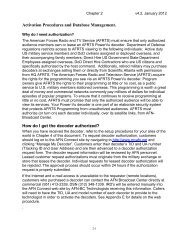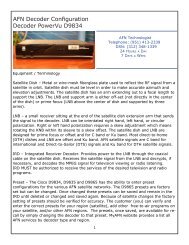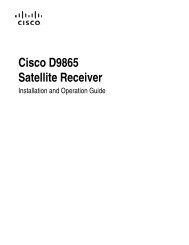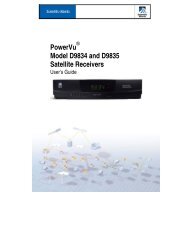AFRTS Defense Media Center Satellite Handbook
AFRTS Defense Media Center Satellite Handbook
AFRTS Defense Media Center Satellite Handbook
Create successful ePaper yourself
Turn your PDF publications into a flip-book with our unique Google optimized e-Paper software.
<strong>Defense</strong> <strong>Media</strong> <strong>Center</strong> <strong>Satellite</strong> <strong>Handbook</strong> V.3.26<br />
Appendix B: RF Link Budgets<br />
SATNET: The following technical information is presented to assist personnel who<br />
operate SATNET satellite reception systems. The information presented is for reference<br />
purposes only; for assistance with actual satellite design requirements for your location,<br />
please contact HQ <strong>AFRTS</strong> or <strong>AFRTS</strong>-BC engineering.<br />
DTS: The following technical information is presented to assist personnel who operate<br />
DTS satellite reception systems both aboard ship and at land based locations. The<br />
information presented is for reference purposes only; for assistance with actual satellite<br />
design requirements for your location, please contact <strong>AFRTS</strong>. For DTS shipboard<br />
applications please contact Naval <strong>Media</strong> <strong>Center</strong>, Washington, DC, or the Space and<br />
Naval Warfare Systems Command, San Diego, CA.<br />
RF Link Budgets: An RF link budget is primarily a series of calculations that<br />
determine the signal loss between a satellite transmitter and a given earth station or<br />
receive antenna. The main consideration in these calculations is downlink carrier-tonoise<br />
density (C/NO) which is represented by equation (1):<br />
C/NO = EIRP – PL + G/T + 228.6 (1)<br />
Where:<br />
EIRP = <strong>Satellite</strong>’s Effective Isotropic Radiated Power expressed in dBW. The satellite<br />
operator specifies this figure. For the SATNET and DTS C-Band Service, in the POR ,<br />
the EIRP 29 dBW, in the AOR the EIRP 30.5 dBW, and the SATNET Ku-Band Service’s<br />
EIRP is 47.7 dBW.<br />
PL = Path Loss expressed in dB. This is the free space dissipation of the satellite’s<br />
transmitted power as a function of distance. The PL calculation is shown in equation (2)<br />
below.<br />
G/T = Earth station figure of merit expressed in dB/K. The G/T calculation is shown in<br />
equation (3) below.<br />
228.6 = Boltzmann’s constant expressed in dB/K/Hz.<br />
PL = 185.0 + 10LOG[1-(0.295 CosH CosAL)] + 20LOG(Frequency in GHz) (2)<br />
Where:<br />
H = Earth station latitude<br />
AL = Difference in longitude of the satellite and the earth station<br />
G/T = Net Antenna Gain – 10LOG(System Noise Temperature) (3)<br />
Where:<br />
Net Antenna Gain = antenna gain – waveguide losses – coupler mismatch losses<br />
System Noise Temperature = LNB noise temperature + antenna noise temperature +<br />
VSWR noise contribution and mismatch loss + interface waveguide noise.<br />
Appendix B page 57


